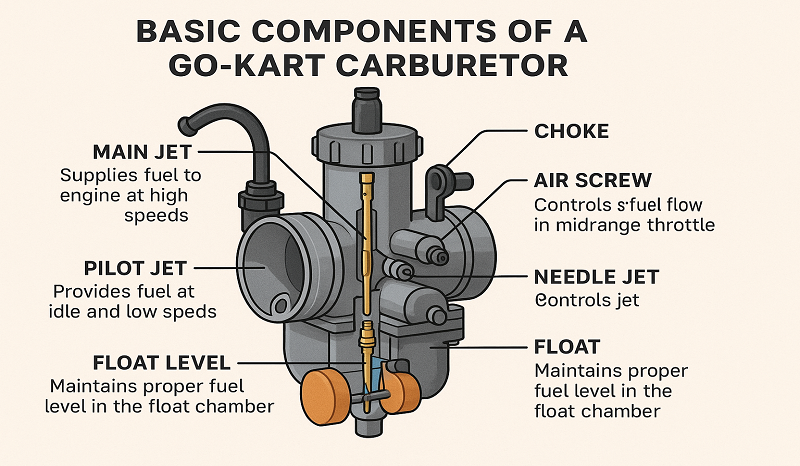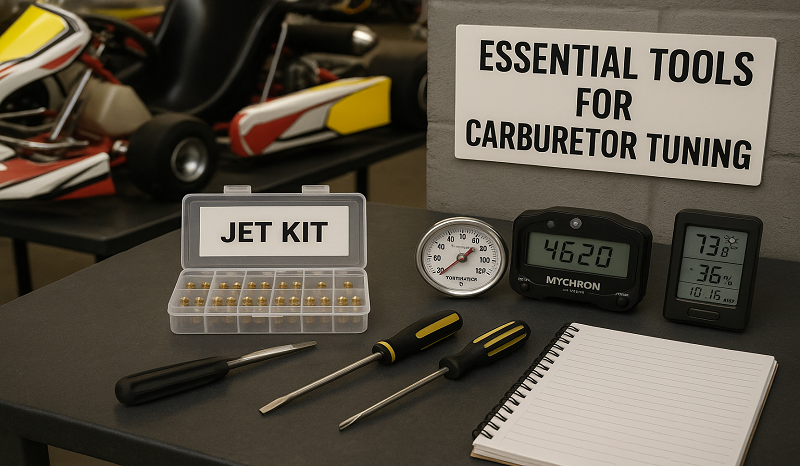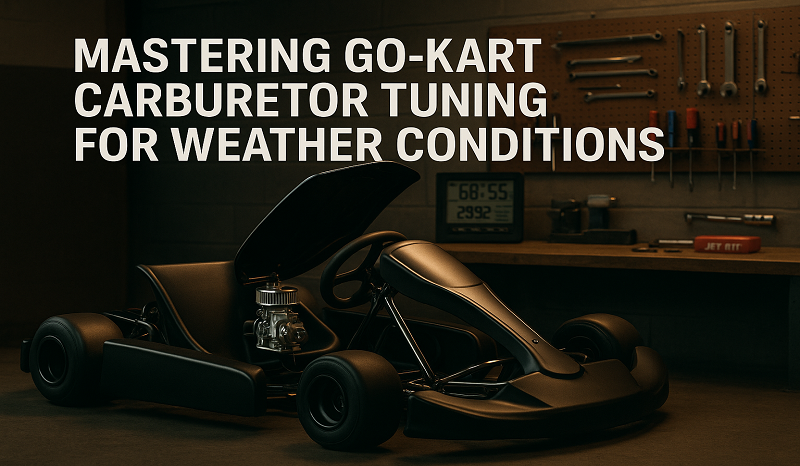Have you ever been excited for race day, only to find your go-kart sputtering and losing power because the weather changed overnight? I’ve been there, and it’s incredibly frustrating. After years of racing and countless hours spent hunched over engines, I’ve learned that properly tuning your go-kart carburetor for different weather conditions can be the difference between standing on the podium and watching from the sidelines.
Weather impacts every aspect of go-kart performance, but nothing quite as dramatically as carburetor function. In this comprehensive guide, I’ll walk you through everything you need to know about go-kart carburetor tuning for weather conditions, from basic principles to advanced techniques that will keep your engine running optimally whether it’s freezing cold or blazing hot.
Why Weather Affects Your Carburetor Performance
Before diving into specific tuning techniques, it’s important to understand why weather conditions have such a profound impact on carburetor performance. Carburetors are essentially air-fuel mixing devices that rely on atmospheric conditions to function properly.
Here’s what happens when weather conditions change:
- Temperature changes: Affect air density and fuel vaporization
- Humidity fluctuations: Alter oxygen content in the air
- Barometric pressure shifts: Change the air-fuel mixture ratio
- Altitude variations: Modify air density and oxygen availability
Each of these factors requires different carburetor adjustments to maintain optimal engine performance. When racing in different weather conditions, understanding these relationships becomes crucial to your success.
The Basic Components of a Go-Kart Carburetor

Let’s get familiar with the key components of a typical go-kart carburetor that you’ll be adjusting:
- Main jet: Controls fuel flow during high-speed operation
- Pilot jet: Regulates fuel delivery at idle and low speeds
- Needle jet: Manages fuel flow during mid-range operation
- Air screw: Fine-tunes the air-fuel mixture at idle
- Float level: Determines the amount of fuel in the float bowl
- Choke: Enriches the mixture for cold starts
Understanding how each component affects engine performance is essential for proper tuning. If you’re new to go-kart maintenance, taking some time to familiarize yourself with these parts will make the tuning process much easier.
Essential Tools for Carburetor Tuning

Before we start adjusting anything, let’s make sure you have the right tools for the job:
- Jet kit: Various sized main and pilot jets
- Screwdrivers: Flathead and Phillips for adjustments
- Temperature gauge: To monitor engine and ambient temperatures
- Tachometer: For measuring RPM changes
- Weather station: To track temperature, humidity, and pressure
- Notebook: To record settings and results
Having these tools ready will make your tuning sessions much more efficient and precise. Remember, proper carburetor tuning is as much science as it is art—detailed records of your adjustments and their effects will help you develop intuition over time.
Go-Kart Carburetor Weather Tuning Calculator
Go-Kart Carburetor Weather Tuning Calculator
Recommended Carburetor Adjustments
Cold Weather Carburetor Tuning Techniques
When the temperature drops, your go-kart’s carburetor needs specific adjustments to compensate for denser air and poorer fuel atomization. Here’s my step-by-step approach:
1. Enrich the Fuel Mixture
In cold weather, you’ll typically need a richer fuel mixture. This means:
- Increase main jet size: Go up 2-4 sizes from your baseline setting
- Adjust the needle position: Raise the clip position 1-2 notches
- Turn the air screw in: About 1/4 to 1/2 turn from your baseline
2. Optimize Cold Starting
Starting a go-kart in cold weather can be challenging. Here’s how to make it easier:
- Use the choke properly: Fully engage for initial start, then gradually disengage
- Warm up gradually: Allow 3-5 minutes of idle time before full throttle
- Consider pre-heating: Cover the engine or use a heat gun to warm critical components
3. Monitor and Fine-Tune
After initial adjustments, pay attention to how your engine responds:
- Spark plug reading: Should show a light tan color, not white (too lean) or black (too rich)
- Throttle response: Should be crisp without hesitation
- Exhaust note: Listen for a clean, consistent sound
Cold weather tuning requires patience and attention to detail. If you’re racing in particularly frigid conditions, you might also want to consider proper racing gear to keep yourself comfortable while making these adjustments.
Hot Weather Carburetor Tuning Strategies
Hot weather presents its own set of challenges for carburetor tuning. Here’s how to adapt:
1. Lean the Fuel Mixture
When temperatures rise, air becomes less dense, requiring less fuel:
- Decrease main jet size: Go down 2-4 sizes from your baseline
- Lower the needle position: Drop the clip position 1-2 notches
- Turn the air screw out: About 1/4 to 1/2 turn from baseline
2. Prevent Vapor Lock
Hot weather can cause fuel to vaporize in the fuel lines or float bowl, creating vapor lock:
- Insulate fuel lines: Use heat-resistant sleeve material
- Install heat shields: Protect the carburetor from engine heat
- Consider a cool can: A device that reduces fuel temperature
3. Adjust Float Levels
Hot weather may require float level adjustments:
- Slightly lower float level: Reduces the chance of overflow
- Check for leaks: Heat can cause gaskets to expand or contract
In extremely hot conditions, engine cooling becomes critical. Make sure your go-kart maintenance includes checking cooling systems and considering additional cooling options if necessary.
Humidity Considerations for Carburetor Tuning
Humidity is often overlooked but has a significant impact on carburetor performance:
High Humidity Settings
When humidity is high, the air contains water vapor that displaces oxygen:
- Slightly lean the mixture: Decrease main jet by 1-2 sizes
- Adjust ignition timing: May need to advance slightly
- Monitor engine temperature: Humid air can affect cooling efficiency
Low Humidity Settings
In dry conditions, oxygen content is higher:
- Slightly richen the mixture: Increase main jet by 1-2 sizes
- Check for air leaks: Dry conditions can shrink gaskets
- Watch for overheating: Dry air doesn’t dissipate heat as effectively
Keeping track of humidity levels at your local go-kart track can help you anticipate necessary adjustments before race day.
Altitude Effects on Carburetor Performance
If you race at tracks with different elevations, you’ll need to consider altitude in your tuning:
High Altitude Adjustments
For every 1,000 feet of elevation gain:
- Decrease main jet size: Approximately 4% smaller
- Adjust idle mixture: Lean it slightly
- Re-evaluate gearing: You may need different gear ratios at higher altitudes
Sea Level to Mountain Transitions
When transitioning between significantly different elevations:
- Create altitude-specific jet kits: Label and organize jets for different tracks
- Document settings: Keep detailed notes of successful configurations
- Allow adjustment time: Schedule practice sessions for tuning at new elevations
Understanding how altitude affects your engine’s performance can give you a competitive edge, especially if you race in mountainous regions or travel to competitions at varying elevations.
Creating a Weather-Based Tuning Chart
One of the most valuable tools you can develop is a personalized weather-based tuning chart. Here’s how to create one:
- Record baseline settings: Document your optimal setup in “standard” conditions
- Track weather variables: Note temperature, humidity, pressure for each session
- Document adjustments: Record what changes you made for each condition
- Note performance results: Track how the kart performed with those adjustments
- Refine over time: Update your chart as you gain experience
Here’s a simplified example of what your chart might look like:
Carburetor Tuning Settings by Weather Conditions
| Weather Condition | Temp (°F) | Humidity | Main Jet | Pilot Jet | Needle Position | Air Screw |
|---|---|---|---|---|---|---|
| Cold & Dry | 40-55 | <30% | 125 | 42 | Position 3 | 1.5 turns |
| Cold & Humid | 40-55 | >60% | 122 | 42 | Position 3 | 1.75 turns |
| Mild & Dry | 65-75 | <30% | 118 | 40 | Position 2 | 2 turns |
| Mild & Humid | 65-75 | >60% | 115 | 40 | Position 2 | 2.25 turns |
| Hot & Dry | 85+ | <30% | 112 | 38 | Position 1 | 2.5 turns |
| Hot & Humid | 85+ | >60% | 110 | 38 | Position 1 | 2.75 turns |
This chart becomes your personal tuning guide, saving you time and guesswork as you encounter different weather conditions throughout the racing season.
Transitional Weather Challenges
Some of the most challenging conditions for carburetor tuning occur during weather transitions:
Morning to Afternoon Shifts
As temperatures rise throughout the day:
- Start slightly rich: Begin with a slightly richer mixture than you think you need
- Plan for mid-day adjustments: Schedule time between heats to make changes
- Monitor engine temperature: Use this as an indicator for when adjustments are needed
Rain and Wet Conditions
When dealing with rain or wet tracks:
- Focus on throttle response: Smooth delivery becomes critical
- Consider a slightly richer mixture: Helps with drivability in slick conditions
- Check your wet weather racing techniques: Carburetor tuning is just one aspect of wet weather performance
Being prepared for changing conditions gives you a significant advantage over competitors who set their carburetors once and hope for the best.
Advanced Tuning Techniques for Competitive Racing
For those looking to extract every ounce of performance, here are some advanced tuning techniques:
Pressure Differential Testing
- Use a vacuum gauge to test the pressure differential across the carburetor
- Helps identify optimal needle positions and jet sizes with precision
- Requires specialized equipment but provides data-driven results
Temperature Mapping
- Install temperature sensors at key points (cylinder head, exhaust, intake)
- Map temperature changes across different weather conditions
- Use this data to predict optimal carburetor settings
Fuel Analysis
- Test fuel specific gravity at different temperatures
- Adjust mixture based on fuel properties
- Consider fuel additives for specific weather conditions
These advanced techniques are used by professional teams but can be adapted for serious amateur racers looking to gain a competitive edge.
Troubleshooting Common Weather-Related Carburetor Issues
Even with careful tuning, you might encounter these common problems:
Symptoms of Running Too Rich
- Black, sooty spark plugs
- Sluggish acceleration
- Excessive smoke from exhaust
- Poor fuel economy
Solution: Decrease main jet size, lower needle position, or turn air screw out slightly.
Symptoms of Running Too Lean
- White, chalky spark plugs
- Engine overheating
- Hesitation during acceleration
- Popping or backfiring
Solution: Increase main jet size, raise needle position, or turn air screw in slightly.
Bogging or Hesitation
- Engine hesitates when throttle is applied quickly
- Most common in cold or humid conditions
Solution: Check accelerator pump function, adjust needle position, or slightly richen mixture.
Understanding these symptoms helps you quickly diagnose and fix issues during practice sessions or between races. For more comprehensive troubleshooting, check out this guide on fixing go-kart carburetor issues.
Maintaining Your Carburetor for All-Weather Performance
Regular maintenance ensures your carburetor can be properly tuned regardless of weather conditions:
Cleaning Schedule
- After every 5-10 hours of operation: Basic external cleaning
- Every 20-30 hours: Partial disassembly and cleaning
- Every season: Complete disassembly and thorough cleaning
Proper Storage
- Store with empty float bowl in temperature-controlled environment
- Use fuel stabilizer if storing with fuel
- Cover air intake to prevent dust and moisture
Inspection Points
- Check for worn throttle shafts
- Inspect gaskets and O-rings for deterioration
- Look for cracks or damage to carburetor body
Proper maintenance not only extends the life of your carburetor but also ensures consistent performance across varying weather conditions. Learn more about cleaning your go-kart carburetor for optimal performance.
Selecting the Right Carburetor for Weather Versatility
Not all carburetors are created equal when it comes to weather adaptability:
Features to Look For
- Wide adjustment range: Allows for greater tuning flexibility
- Quality materials: Less susceptible to temperature expansion/contraction
- Replaceable jets and needles: Makes weather-specific tuning easier
- Good throttle response: Critical for changing track conditions
If you’re in the market for a new carburetor, check out this guide on the best go-kart carburetors for various applications and weather conditions.
Real-World Case Studies
Let me share a few real-world examples of how proper weather-based carburetor tuning made a difference:
Case Study 1
A racer was struggling with morning qualifying sessions but excelling in afternoon races. By creating two distinct carburetor setups—a richer mixture with a larger main jet for morning runs and a leaner setup for afternoon heats—they were able to achieve consistent performance throughout the day.
Case Study 2
One team regularly raced at tracks with a 2,000-foot elevation difference. They created pre-configured jet kits for each track, with detailed notes on weather adjustments. This systematic approach allowed them to quickly adapt to both elevation and weather changes without extensive testing at each venue.
Case Study 3: Humidity Mastery
A racer who consistently struggled in humid conditions discovered that adjusting both the main jet and needle position could compensate for the reduced oxygen content. By creating a humidity-specific tuning protocol, they turned their weakness into a strength.
These real-world examples demonstrate how understanding and adapting to weather conditions can transform your racing performance.
The Weather Tuning Mindset
Developing expertise in weather-based carburetor tuning requires more than technical knowledge—it demands a specific mindset:
- Patience: Weather tuning takes time and careful observation
- Methodical approach: Change one variable at a time
- Record keeping: Document everything, even seemingly minor details
- Continuous learning: Weather patterns and their effects are always evolving
- Pre-race preparation: Check forecasts and prepare accordingly
Conclusion
Mastering go-kart carburetor tuning for different weather conditions isn’t just about technical adjustments—it’s about developing an intuitive understanding of how your engine breathes and performs across a spectrum of environmental conditions.
Remember that carburetor tuning is just one aspect of go-kart performance. For best results, combine your weather-based tuning knowledge with proper tire preparation, appropriate safety equipment, and solid driving techniques.

Goran, an experienced go-kart racer, fuels GoKartLife.com with his passion and expertise. He offers valuable insights and tips for fellow enthusiasts, fostering the growth of the go-kart community. Join Goran at GoKartLife.com and immerse yourself in this exhilarating sport.
Last modified: May 10, 2025


